Timeline: The Autopen Debate
Key political and legal arguments through the years, and the documents behind them.
The House Oversight Committee’s report, “The Biden Autopen Presidency,” can be broken down into two basic parts:
Biden’s inner circle — or “politburo,” as the report characterizes it — worked like the two guys in Weekend at Bernie’s, constantly propping up the president to hide his declining cognitive condition from the public.
As a result, Biden was often not in charge, thus the need for the administration to use the autopen multiple times.
The report reaches a conclusion that reads like a judicial ruling: Absent evidence that Biden made executive decisions, “the Committee deems those actions taken through use of the autopen as void.” The report continues:
Barring evidence of executive actions taken during the Biden presidency showing that President Biden indeed took a particular executive action, the Committee deems those actions taken through use of the autopen as void. The validity of the executive actions allegedly approved and signed (largely by autopen) by President Biden must be reviewed to determine whether legal action is necessary to ameliorate consequences of any illegitimate pardons granted, or executive actions implemented, throughout the Biden Autopen Presidency. The Committee finds numerous executive actions—particularly clemency actions—taken during the Biden Administration were illegitimate.
Attorney General Pam Bondi responded the morning the report was released, saying her team was reviewing Biden’s use of the autopen for pardons.
The Oversight Committee’s report focuses on “executive actions,” particularly Biden’s last-minute pre-emptive pardons of family members and characters such as Anthony Fauci.
A federal appeals court said in a 2024 ruling that a pardon or commutation doesn’t require a president’s signature as long as it can be demonstrated that the president made the decision. The Oversight Committee’s report tries to make the case that proof of Biden’s executive actions is missing.
The Biden White House’s executive decision-making procedures were so lax that the chain of custody for a given decision is difficult or impossible to establish. Documents that were used to predicate executive actions should be sufficiently traceable to ensure they reflect the will of the president. Instead, the Biden White House’s flimsy procedure appears to have been extremely vulnerable to abuse.
Interestingly, the committee’s report does not address legislation that was signed by autopen, even though the U.S. Constitution says presidents “shall” sign bills they approve. Still, courts have not ruled whether it’s legal to sign legislation with an autopen. In 2011, President Obama became the first president to “sign” legislation by autopen. The administration relied on a 2005 Justice Department opinion for its legal justification.
You can read more about that opinion below as part of Racket News’ timeline of events, controversies and key documents concerning the autopen.
March 27, 1929
Acting Solicitor General Alfred Wheat writes a memorandum that says presidential pardons do not require an “autograph,” but that “custom and propriety require that the pardoned man be given some token to show that he has been pardoned.”
July 7, 2005
The Justice Department’s Office of Legal Counsel issue an opinion that concludes:
The President need not personally perform the physical act of affixing his signature to a bill he approves and decides to sign in order for the bill to become law. Rather, the President may sign a bill within the meaning of Article I, Section 7 by directing a subordinate to affix the President’s signature to such a bill, for example by autopen.”
Although the Justice Department researched the topic at the request of the White House, President Bush never signed legislation with the autopen.
May 26, 2011
President Obama becomes the first president to sign legislation with the autopen. The president was in Deauville, France, for the G8 Summit while Congress voted to extend provisions in the Patriot Act. They would have expired without his immediate signature.
May 27, 2011
Georgia Congressman Tom Graves expresses concerns about the autopen in a letter to Obama. Graves notes the U.S. Constitution says the president “shall” sign legislation he approves, and seeks clarity that Obama was fully informed of what he had the autopen sign.
Mr. President, I write to request your confirmation that S. 990, as passed by Congress, was presented to you prior to the autopen signing, as well as a detailed, written explanation of your Constitutional authority to assign a surrogate the responsibility of signing bills passed by Congress into law.
Graves follows up in a June 17, 2011 letter to Obama that asks him to re-sign the legislation with his real signature. This time, 20 Republican colleagues also sign the letter.
January 2, 2013
The Obama administration for the second time uses an autopen to sign legislation while the president is on vacation in Hawaii. The autopen was used to sign high-profile “fiscal cliff” legislation to avoid spending cuts that would have taken effect if tax breaks were not extended.
February 13, 2024
The Fourth U.S. Circuit Court of Appeals references the 1929 Wheat memo in a ruling that says pardons don’t require a president’s signature as long as it’s clear the president made the clemency decision.
“…nothing in the Constitution restricts the President’s exercise of the clemency power to commutations that have been rendered through a documented writing…But such a clemency warrant or, indeed, any writing, is not required for the President to exercise this authority under the Constitution. Hypothetically, the President could proclaim at a press conference in the Rose Garden that he has pardoned a particular individual, and that would be a valid act…even absent a writing.”
March 14-17, 2025
President Trump posts on Truth Social that whoever controlled the autopen was the real president during the Biden Administration. He also declares the Biden’s pardons are “VOID, VACANT, AND OF NO FURTHER FORCE OR EFFECT” because they were signed by an autopen.
March 17, 2025
The conservative Heritage Foundation’s “Oversight Project” determines that 32 of Biden’s 51 clemency warrants (affecting 4,245 people) were signed by two different autopen signatures. This finding was cited in the House Oversight Committee’s report.
The Oversight Project also argues the 2005 legal opinion on the autopen was wrong, and “the Biden Administration’s apparent rampant use of the autopen reveals the very reason that OLC’s 2005 Opinion is erroneous at its core. Once the requirement for a wet signature is dispensed with, an important safeguard against fraud is removed, and an historical lawless Administration combined with a cognitively impaired President leads to the exact situation we are in—no one can be sure what actions President Biden actually authorized.”
June 4, 2025
Trump writes a memo that directs his White House counsel to work with the Attorney General to investigate Biden’s use of the autopen. From the memo:
Given clear indications that President Biden lacked the capacity to exercise his Presidential authority, if his advisors secretly used the mechanical signature pen to conceal this incapacity, while taking radical executive actions all in his name, that would constitute an unconstitutional wielding of the power of the Presidency, a circumstance that would have implications for the legality and validity of numerous executive actions undertaken in Biden’s name.
A formal report in response to this directive has not been released.
July 13, 2025
Biden defends his administration’s use of the autopen, telling the New York Times that “I made every decision” in regard to the pardons and commutations he made at the end of his term. The Times also posted excerpts of its 10-minute phone interview with him.
September 24, 2025
A new display of presidential portraits debuts outside the West Wing, but in place of Biden’s face is a framed picture of an autopen signing Biden’s name.
October 28, 2025
Republicans on the House Oversight Committee release a 91-page report that alleges Biden’s “loyal senior staff” engaged in a cover-up of his declining health and “numerous instances in which the president’s approval for an executive action or the chief of staff’s approval of signature by autopen was not memorialized.”
The report includes testimony of a Biden administration official, Anthony Bernal, who served as an assistant to the president and as chief of staff to first lady Jill Biden.
In the video above, Bernal is asked if “any unelected official or family member of President Joe Biden execute[d] the duties of the Presidency?”
Bernal answers by exercising his Fifth Amendment rights.
Meanwhile Democrats on the Oversight Committee release a 14-page rebuttal. That report gives examples of Biden Administration officials testifying that Biden “managed complex policy discussions.”
Moreover, the autopen “scandal” manufactured by Chairman Comer and House Republicans proved to be nothing more than a feeble attempt to attack the legitimacy of President Biden’s policies—a pretext to invalidate executive actions by President Biden, including valid pardons issued pursuant to his constitutional authority. After extensive witness interviews and numerous media appearances, the Majority has produced no credible evidence to substantiate his assertions, demonstrating once again his preference for partisanship over genuine oversight.


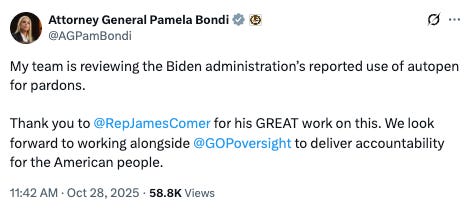

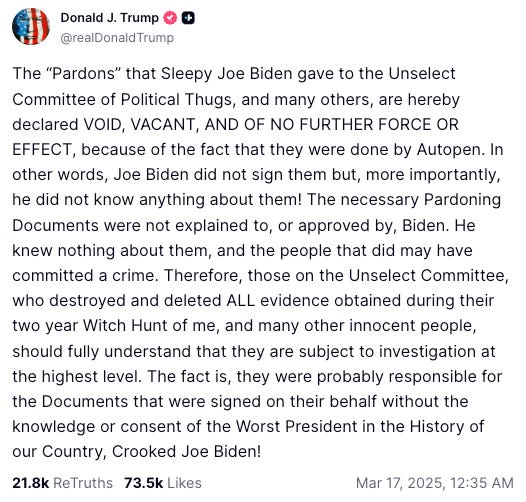
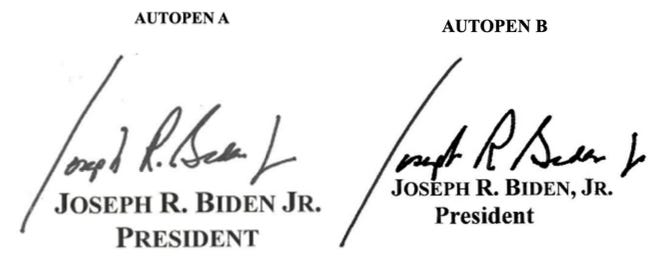
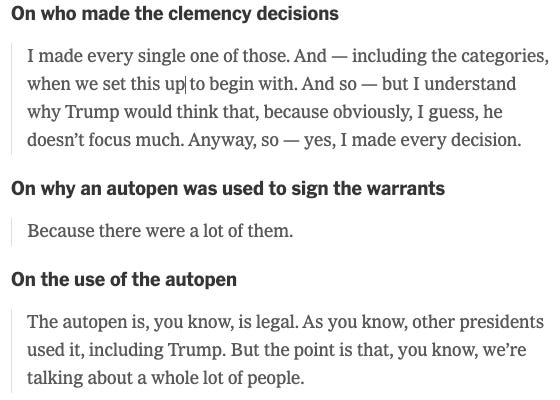
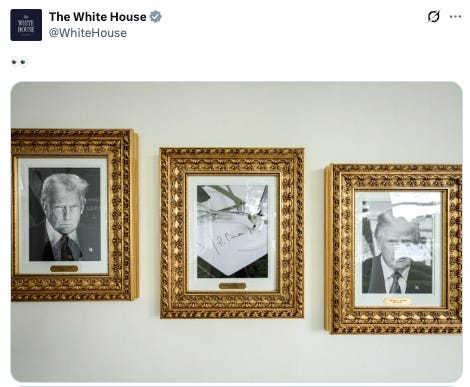

It’s always fascinating to see legal opinions by a non-judge attorney (for example the DOJ or Office of Legal Counsel - who are merely advisors to the president) trotted out as legally binding authority. The Supreme Court needs to weigh in on the legality of autopen use particularly in light of the situation we had where the president had dementia and was not legally competent to sign anything during on of his frequent “bad days”.
Great breakdown, Greg. Biden advisor Tom Donilon testified that he would receive a million bonus on top of $4 million salary if they win reelection. Might help to see a timeline of which signatures are autopen and whether they can be declared null and void.